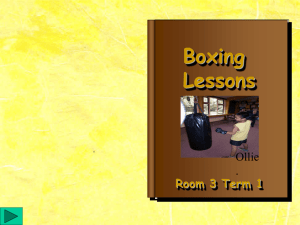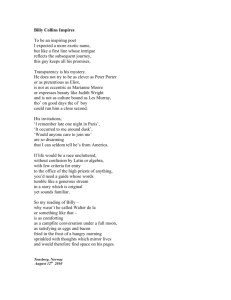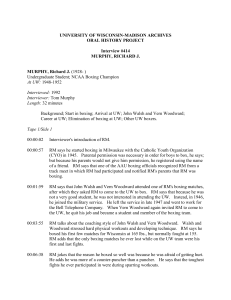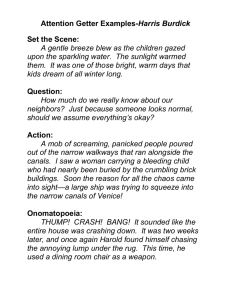Eksamen er delt inn i to deler, part A og part B. Part A inneholder tre
advertisement
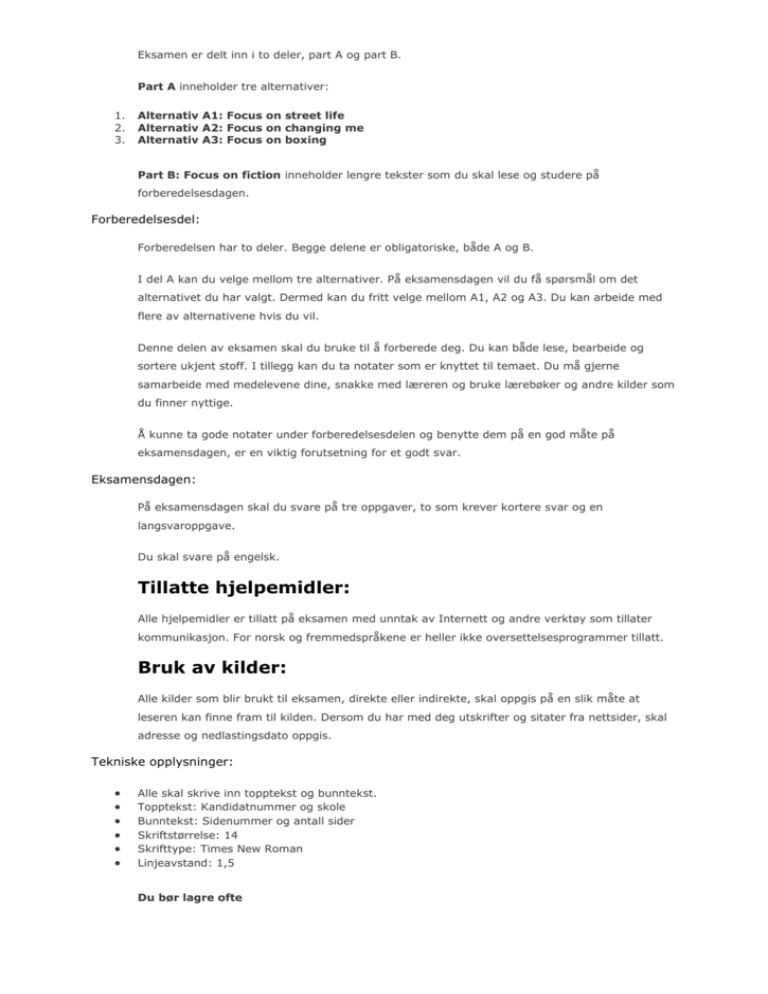
Eksamen er delt inn i to deler, part A og part B. Part A inneholder tre alternativer: 1. 2. 3. Alternativ A1: Focus on street life Alternativ A2: Focus on changing me Alternativ A3: Focus on boxing Part B: Focus on fiction inneholder lengre tekster som du skal lese og studere på forberedelsesdagen. Forberedelsesdel: Forberedelsen har to deler. Begge delene er obligatoriske, både A og B. I del A kan du velge mellom tre alternativer. På eksamensdagen vil du få spørsmål om det alternativet du har valgt. Dermed kan du fritt velge mellom A1, A2 og A3. Du kan arbeide med flere av alternativene hvis du vil. Denne delen av eksamen skal du bruke til å forberede deg. Du kan både lese, bearbeide og sortere ukjent stoff. I tillegg kan du ta notater som er knyttet til temaet. Du må gjerne samarbeide med medelevene dine, snakke med læreren og bruke lærebøker og andre kilder som du finner nyttige. Å kunne ta gode notater under forberedelsesdelen og benytte dem på en god måte på eksamensdagen, er en viktig forutsetning for et godt svar. Eksamensdagen: På eksamensdagen skal du svare på tre oppgaver, to som krever kortere svar og en langsvaroppgave. Du skal svare på engelsk. Tillatte hjelpemidler: Alle hjelpemidler er tillatt på eksamen med unntak av Internett og andre verktøy som tillater kommunikasjon. For norsk og fremmedspråkene er heller ikke oversettelsesprogrammer tillatt. Bruk av kilder: Alle kilder som blir brukt til eksamen, direkte eller indirekte, skal oppgis på en slik måte at leseren kan finne fram til kilden. Dersom du har med deg utskrifter og sitater fra nettsider, skal adresse og nedlastingsdato oppgis. Tekniske opplysninger: Alle skal skrive inn topptekst og bunntekst. Topptekst: Kandidatnummer og skole Bunntekst: Sidenummer og antall sider Skriftstørrelse: 14 Skrifttype: Times New Roman Linjeavstand: 1,5 Du bør lagre ofte Alternative A1 Focus on street life Alternative A1 Focus on street life The street artist known as Banksy is a mystery. Nobody knows who he is or where he lives but a lot of people know his street art. Banksy often combines graffiti with comments on politics, culture, or ethics. Where will his next piece of art appear? Public to decide art or graffiti? People living in Bristol may be asked to vote on whether graffiti should be left on buildings or removed, in an attempt to promote street artists. Under the plan, the city council will ask the public to decide whether murals are art or graffiti tags. As part of a street art policy, council contractors will not take action if people vote to keep wall paintings. Positive contribution Although the council has pledged to remove offensive and unsightly graffiti, a street art policy will "seek to define and support the display of public art". The plan states that "where people tell us that murals or artworks make a positive contribution to the local environment and where the property owner has raised no objection" the council will not remove the graffiti. Councillor Gary Hopkins said: "We have said informally that if it is street art that people like we will keep it, but we want to formalise it now into a policy.” "Tagging will still be removed, but if it is art that people say they want to see, they can take a photo and upload it on to our consultation website and we will ask people what they think." Source: www.telegraph.co.uk Source: "ferretfacejones" Portrait of the street artist who gave America an icon By Leonard Boyle Saturday, 10 January 2009 Shepard Fairey’s images often landed him in jail - now he hangs at Washington’s National Gallery. From skateboarder to famous street artist, Shepard Fairey has seen the inside of numerous police cells in his long career. The artist’s most recent arrest was last August when he was in Denver for Mr Obama’s nomination to stand as the Democratic presidential candidate. He was busy postering an alleyway with some friends while a film crew documented their work, when riot police showed up. While Mr Obama was accepting the Democratic nomination, Fairey, out of jail with a slap on the wrist, was already filming a YouTube account of the 14th arrest in his meteoric career as America’s foremost street artist. Emerging from humble beginnings in the back alleys of Los Angeles, the portrait became an instant sensation, a pop culture “icon” that was willingly embraced by the Obama political Machine. The portrait has become part of the Smithsonian’s permanent collection at the National Portrait Gallery, which is conveniently only a few blocks from the White House. The portrait gallery is better known for its stuffy collection of George Washington portraits than street art, but the museum’s curator, Carolyn Kinder Carr, said simply:” We all fell in love with it. We always like portraits that reflect a particular moment in history, and we like the fact that it is an image that resides in popular culture.” Source: www.independent.co.uk Source: National Portrait Gallery, Shepard Fairey Play me I'm yours Source: www.streetpianos.com/ london2009/pianos/st-mary-le bow Touring internationally since 2008, 'Play Me, I'm Yours' is an artwork by artist Luke Jerram. Street pianos are appearing in cities across the world. Located in parks, squares, bus shelters and train stations, outside galleries, markets and on bridges and ferries, the pianos are for any member of the public to enjoy and claim ownership of. 112 pianos have been installed so far. Many pianos are personalised and decorated. Who plays them and how long they remain is up to each community. Each piano acts as a sculptural, musical, blank canvas that comes to reflect the community where it is placed. Source: www.streetpianos.com http://kids.tate.org.uk/games/street-art Many young people are kept off the streets by playing a sport or becoming involved in music. Many young people are kept off the streets by playing a sport or becoming involved in music. They focus on running or playing football or table tennis or singing in a choir or playing in a group. But Khadijah Williams focused on school - it was her ticket to not living on the street. From homeless to Harvard Khadijah at her graduation. Source: seattletimes.nwsource.com "She has attended 12 schools in 12 years; lived out of garbage bags among pimps, prostitutes and drug dealers." By Esmeralda Bermudez Los Angeles Times Here is an extract from a newspaper article in The Seattle Times about Kahdijah. As long as she can remember, Khadijah Williams has floated from shelters to motels and back to shelters along the West Coast with her mother. She has attended 12 schools in 12 years; lived out of garbage bags among pimps, prostitutes and drug dealers. Every morning, she made sure she didn't smell or look hopelessly untidy. Williams was in third grade when her teachers marked the 9-year-old as gifted. In the years that followed, her mother pulled her out of school eight more times. When shelters closed, money ran out or her mother did not feel safe, they packed what little they carried and boarded buses to find housing in Los Angeles, San Francisco, Ventura, San Diego, San Bernardino and Orange County, staying for months, at most, in one place. She finished only half of fourth grade, half of fifth and skipped sixth. Seventh grade was split between Los Angeles and San Diego. Eighth grade consisted of two weeks in San Bernardino. In 10th grade, she realized that if she wanted to succeed, she couldn't do it alone. She began to reach out to organizations and mentors, teachers, counselors and college alumni networks. When she enrolled in the fall of her junior year at Jefferson High School, about five miles southeast of downtown Los Angeles, she was determined to stay put, regardless of where her mother moved. This soon meant commuting by bus from an Orange County shelter. She awoke at 4 a.m. and returned at 11 p.m., and kept her grade-point average at just below 4.0 while participating in the Academic Decathlon, the debate team and leading the school's track and field team. "That's when I was really stressed," she said of that time. Williams graduated with high honors, fourth in her class. She was accepted to more than 20 universities nationwide, including Brown, Columbia, Amherst and Williams. She chose a full scholarship to Harvard and hopes to become an education attorney. Source: seattletimes.nwsource.com http://www.khadijahwilliams.com/ Khadijah Williams got off the street by studying hard. In Q & A, Ram gets off the street by being streetwise and VERY observant. Q&A By Vikas Swarup Extract from the book In this episode, Ram has had money to spend, but it has been stolen from him, so now he is back on the street. And his only thought is for... Food. That is all I can see, hear, think and smell on the crowded and noisy railway station where I have been standing in my cotton shirt and Levi jeans for the past two hours. If you don’t eat for a while, the hunger just shrivels up and dies. But if you don’t eat for a long time – and I have not had a meal since yesterday afternoon – your brain does funny things. All around me I can only see people eating and drinking. And my nose follows the trail of food like a dog sniffing out a bone. The aroma of freshly made jalebis, puasbasic as a boiled eggris and kachoris makes me dizzy. But when I finger my pocket I discover only a one-rupee coin, and after last night’s loss of my fifty thousand rupees, it doesn’t seem lucky any longer. So I lick my parched lips and wonder how to kill my hunger. My eyes fall on a hoarding next to the railway canteen. It says simply, ‘M - Just one kilometre away.’ I know instantly where I can get food. For free. I leave Agra station and set about searching for the big M sign. I find it eventually in the heart of a posh market. The smartly attired waiters at McDonald’s look at me suspiciously but don’t shoo me away. They can’t turn back a customer in Levi jeans, however scruffy he might be. I position myself close to the wooden bin, the one with the swing flap. When no one is looking I quickly push my hand inside and take out as many of those nice brown paper bags as are within arm’s reach. I exit after using the clean toilet to wash off some of the dirt and grime from my face. My first attempt at scavenging is quite successful. I sit on a green wooden bench outside and feed contentedly on a half-eaten vegetable burger, some chicken nuggets, two almost full packets of French fries and half a cup of 7Up. Scavenging is part of the survival gear of a street kid. Extract from Q & A by Vikas Swarup, pages 273-274. Slumdog Millionaire is the film version of Q & A. Pictures from the film Slumdog Millionaire Source: www.inewsindia.com/wp-content/uploads/2009/02/slumdog_millionaire.jpg A neighborhood walk Photograph Jonas Bendiksen Two young children from the Mumbai slums were chosen to be the child stars of the film. When the film won eight Academy Awards in Hollywood in 2008, the young stars were there. So Sunday, Hollywood; Thursday, a Mumbai shanty town. Sunday night, Azharuddin Ismail and Rubina Ali slept in a luxury hotel. Thursday night, Azharuddin slept under a plastic sheet in a shanty town beside a railway track, where the smell of urine and cow dung is in the air. Rubina slept with her parents and siblings in a tiny shack beside an open drain. However, hoping to secure a future for Azharuddin and Rubina, the film’s producers have enrolled them in a school and set up a trust fund to ensure their welfare. "I hope the children get a better life after this," said a neighbour who waited outside her home all day to welcome the children home. "They’ve achieved so much at a young age. They deserve much better." Read more: news.bbc.co.uk/2/shared/spl/hi/world/06/dharavi_slum/ html/dharavi_slum_intro.stm The film Slumdog Millionaire won several awards. Source: http://www.gettyimages.com/detail/84369129/AFP Source: www.between-the-lines.co.uk/ wp-content/uploads/2009/01/ slumdog-millionaire.jpg Alternative A2 Focus on changing me Source: gonyc.about.com/od/chrisstmassights/ss/2005_bloomies_9.htm Queenbees and Wannabees By Rosalind Wiseman Extract from the book It wasn’t so easy One of the things I always felt growing up as someone of mixed racial heritage was that I didn’t fit anywhere. On the one hand, I was presented with the white image of beauty as the blueeyed, blond haired, tall, skinny, big-breasted All-American girl. On the other hand was the Asian image of beauty as petite, slender, long dark hair, exotic features, and pale skin, actresses like Lucy Liu, Ming Na Wen, and the women in Crouching Tiger, Hidden Dragon. The only thing I had in common with any of those images was that I was fair-skinned, otherwise I never felt like I measured up. For people of mixed backgrounds, you kind of fall through the cracks when you look at fashion magazines. It’s also true that Asian women try to look more white. My mother, for instance, puts tape on her eyelids to make them look rounder. One of my Korean friends once told me I was lucky that I had pale skin because when she went to Korea, people told her she looked like "a country girl" because she’s naturally tan. There are also operations that some girls get to make their eyes look more "white," and some girls get nose jobs to make their noses look more "white." This doesn’t occur only in the States either; in Korea, plastic surgery is a huge industry. It’s because they also get Western fashion magazines there and are presented with the Caucasian standard of beauty and will get nose jobs, fix their eyes, and get operations on their jaws to make their faces look less round, less Asian and more white. When you look at women like Jennifer Lopez and Beyonce Knowles, who both have blond highlights and look like white women with tans, you realize that racism still plays itself out in what we are presented with as "beautiful." Growing up and going to school in a town with a large minority population, I thought I was ugly because I didn’t look like any of my friends. It didn’t help that I was a late bloomer and was an extremely awkward adolescent. I had a sudden growth spurt and it took me a while to figure out what to do with arms and legs (clumsy is an understatement). I had straight hair where most of my friends had dark curly hair, I was tall, pale, skinny, and flat-chested, where most of my friends were shorter than I was, had curvy figures, and brown or black skin. Even if girls were my height or taller, they still had curves where I didn’t. The prettiest and most popular girls in my school looked nothing like me and this made me feel ugly in comparison. It was a reversal of wanting to fit the blond, blue-eyed ideal, I wanted to look less white and like more of a minority. It was actually a double-bind because by white standards I wasn’t beautiful either, because I wasn’t blond, blue-eyed, with a big chest. Even so, I rejected the blond image of beauty in favour of wanting to make more of being a minority because I wanted to be accepted in school and be pretty by those standards. Ellie, 21 Extract from Queen bees and Wannabees by Rosalind Wiseman, pages 87-88 http://kidshealth.org/teen/your_mind/body_image/body_image.html The secret diary of Adrian Mole Aged 13 ¾ Friday March 13th The emergency doctor came to my grandma’s last night at 11.30 p.m. He diagnosed that I am suffering from acne vulgaris. He said it was so common that it is regarded as a normal state of adolescence. Wednesday March 24th The only thing that really worries me about my appearance now is my ears. They stick out at an angle of ninety degrees. I have checked them with my geometry set so I know it is a scientific fact. Extracts from The secret diary of Adrian Mole aged 13 ¾ by Sue Townsend, pages 45,46 and 84. My life as a giraffe By Arianne Cohen, The Observer, Sunday 31 May 2009 Most men dream of being 6ft 3in tall, but for women the climb is not nearly as smooth. Pressured to take growth inhibitors at 11, on the therapist's couch at 17, Arianne Cohen only grew to love her stature when she dated a 7ft 2in man. Here, she shares the dizzying highs and lows of life. Photograph Barry J.Holmes The true challenge of tall life is not that you’re tall. Who cares about that - legs are legs. The challenge is everyone can see you, all the time. You’re on display. At least my mother was on my side. She had smartly overloaded my schedule with activities where height was an asset - tennis, dance, swimming. One day in Dr Kauger's waiting room, I watched adorable chemo-stunted boys and girls play below walls muralled with giraffes. Children's illustrators often use giraffes as a neutral mascot of difference. Lynn Sherr, the tall American news anchor wrote: "Because of its height, the giraffe has long been a symbol of people who just don't fit in. They may be too tall or too eccentric, or simply too different from everyone else, like exclamation points on the landscape." An exclamation point. That is exactly what I felt like! I was the sort of child who read. That afternoon I went to the library. The card catalogue said, "Tall: see Giraffe". No mention of "oestrogen" or "height-reduction treatment". I found a book about Memily, by children's writer Stephen Cosgrove: "Week after week, Memily grew and she became sadder and sadder. She was shy and embarrassed by her height, and whenever any of the other creatures walked by she would turn her head, knowing that they had to look up just to look her in the eye." Memily develops a severe slouching problem. So did I. But Memily, apparently, was never offered oestrogen therapy. So I had to make the decision alone. My thinking had little to do with height and more to do with a general aversion to medication: when in doubt, don't take chemicals. At the time, it was simply a decision of passivity. I was frozen. Though I wasn't happy with my body, I didn't want to change it. I told myself that the fastest swimmers in the world were six-footers. Long limbs were important. So I decided to not do anything. I figured I'd just wait and see what happened. There are ways to change your appearance. Sometimes it works, sometimes it doesn’t work and sometimes it is drastic. Tattoo clue led police to thief A car thief who had his name and date of birth tattooed on his neck was caught after CCTV images of him were used to track him down. Aarron Evans, 21, pleaded guilty at Bristol Magistrates' Court to breaking into a covert capture car in the city. The car had been left by Avon and Somerset Police officers with a covert camera concealed inside, which took pictures of Evans. Evans, an illiterate man of no fixed address, was sentenced to seven months. Superintendent Ian Wylie said: "Criminals won't be tolerated in Bristol and we will keep catching them and bringing them before the courts.” Source: www.poe-news.com/stories.php CCTV shows Evans breaking into the car. It can happen to you and your tattoo. The boy who lost his face By Louis Sachar Extract from the book AT RECESS he saw Scott and Roger and everyone hanging out on the steps. Roger was waving his arms, talking about something, and everyone else was laughing. David sighed. He didn’t know what Roger was saying, but he doubted it was very funny. Still, he knew if he was there, he would have laughed too. Leslie Gilroy was wearing Roger’s black vinyl jacket. That was one of the games they played. Whenever a girl wore a boy’s jacket it meant she wasn’t allowed to talk to another boy. Leslie wasn’t even allowed to talk to Randy or Scott without first taking off the jacket. Leslie had long, silky, beautiful blond hair that she was always complaining about. It seemed whenever she wasn’t the center of attention, like when the guys were talking about sports, she’d suddenly say, “I hate my hair. It’s too straight. I wish it was like yours, Ginger.” Ginger had dark frizzy hair. They stopped right in front of him. Leslie took off Roger’s black jacket and handed it to Ginger. Now she was allowed to talk. She turned to David and said, “No girl will ever want to wear your jacket. You’re the ugliest boy in the whole school.” She took the jacket from Ginger and put it back on. Then the two girls turned and walked quickly back to their friends. “I said it!” David heard Leslie exclaim. “I said it right to his face!” “He didn’t do a thing,” said Ginger.” He just sat there.” Extract from The Boy who lost his face by Louis Sachar, pages 43-44 Michael Jackson’s sudden and tragic death has revealed the truly iconic status he had achieved in the world. While some of the news media have chosen to continually harp on what they have labeled as Michael’s eccentricities, especially what they have called his bizarre appearance and behavior over the last few years, his 40 years of unbroken creativity and musical genius have secured his enduring iconic status in the minds of an adoring global public. But he was also still himself – Michael Jackson struggled to live as normal a life as a genius child can live. Michael sensed that his public wanted more and the perfectionist in him demanded that he give more, become more, become larger than his human self, become larger than life. Along the way, he lost track of who he was. Struggling to sustain the larger-than-life icon image, the public face and persona of superstar icon Michael, Michael Jackson became more and more confused and developed more and more distorted views of himself - of who and what Michael Jackson was. He needed to be fixed - to be transformed - to be perfected based on some external standards of beauty. Numerous plastic surgeries and skin treatments killed the physical Michael Jackson and invented the new Superstar image – the icon. Ironically, in the final analysis, his iconic status had little or nothing to do with his physical appearance. The glove, the unique military-like dress, the penny loafers, the white or sequined socks, the moon walk and other dance moves were all props in the making of his iconic image. Source: www.nypl.org/blogs/2009/07/07/Michael-jackson-icon Source: struggleforfashion.blogg.no/images An image of how Michael Jackson looked after many surgical operations and a computer manipulated image of him, showing how he probably would have looked without plastic surgery and possible skin whitening treatment. Sara's face By Melvin Burgess In this extract Bernadette, a former ward sister at Home Manor Farm, talks to the police, an Inspector Alderson. In this conversation Bernadette refers to the boy, who is Sara’s boyfriend. “The boy says Sara thinks they want to steal her face.” “Steal her face? How can they do that?” “They can do that these days. It’s that Dr Kaye - he can do anything. Really anything.” There was silence on the other end of the phone. “I’m not saying it’s true,” begged Bernadette, trying very hard not to cry.” – I’m just saying that’s what she thinks. Now a girl that thinks that, she shouldn’t be going into surgery, should she? Don’t you think, Inspector? Don’t you?” Bernadette ground to a halt, unable to speak. “I’ll look into it. We’ll be in touch, Mrs McNalty.” Bernadette put down the phone, put her head in her hands and cried. She had done what she could. Now it was in other hands than her own. Inspector Alderson was at a bit of loss as to how to proceed. He put in a call to Home Manor Farm, where he got confirmation that yes, actually, an operation was taking place at that moment - very small, nothing much, a girl having some minor burn scars seen to and a few other bits and pieces. A little breast enhancement. The speaker wasn’t sure what, exactly. At last, at long last, a network was rising up to help Sara. But so, so late! Even now, Dr Kaye was peeling away the flesh, while his assistant prepared Heat to receive her beauty. Despite her madness, it was exactly as Sara feared. Before long the front gate was a blaze of TV lights. Images from Home Manor Farm, where a young fan was rumoured to be being subjected to facial surgery she had not consented to - surgery performed by Heat’s notorious surgeon, Dr Wayland Kaye - were being broadcast in every country in the world. There were even rumours that Heat was in the process of stealing her face. Only half an hour before, Sara’s face had been plucked up from the front of her head and laid neatly on the bloodied front of Heat’s. There had as yet been no time to connect any nerves, but to move things further on, Kaye had stitched it on at the tip of his nose. Sara, meanwhile, lay unconscious, paralysed, faceless and expressionless under a sheet, a layer of sterilised tissue over her face to keep the wound fresh. The remains of Heat’s face had already been removed and incinerated. The cameras snapped and rolled and revealed to the world the now famous image of Sara’s face, inert in a way no face ever should be. But it wasn’t Sara who was wearing it – it was Heat himself. Extract from Sara’s Face by Melvin Burgess, pages 219,220,226,228 and 229. Times have changed. Young girls dream of operations like this. It’s like buying new clothes these days. Sara Carter wants to be famous. Fame is her obsession. So when legendary rock star Jonathon Heat offers her star training and the cosmetic surgery she thinks she wants, Sara can’t believe her dream will come true. Alternative A3 Focus on boxing Source: gonyc.about.com/od/chrisstmassights/ss/2005_bloomies_9.htm Muhammad Ali, once a World Heavyweight Champion, now suffering from Parkinson’s Disease, struggled to climb the steep stairs of the stadium before his shaking hand held high the Olympic Torch in 1996. Warhol classics stolen from private collector Los Angeles police are hunting for a multi-million dollar collection of ANDY WARHOL artwork stolen from a private collector earlier this month. Authorities were called out to the home of businessman Richard Weisman after he found 10 pieces of his Warhol collection had been taken. The paintings, hailing from the 1970s and depicting images of Muhammad Ali, O.J. Simpson, and other athletes, were noticed missing by a staff member. L.A. Detective Mark Sommer says, "This was a very clean crime. (The home) wasn't ransacked." Weisman is offering a $1 million (£666,000) reward for the safe return of the artworks. Source: www.contactmusic.com/news.nsf/story/warhol-classics-stolen-from-private-collector_1115824 Made by Andy Warhol Source: www.coskunfineart.com/works.asp?artistID=9 Great Sporting Moments: Muhammad Ali v George Foreman, World Heavyweight title fight, Kinshasa, Zaire, 30 October, 1974. One was a huge and apparently invincible ogre. The other was past his best, with question-marks over his stamina – and, some said, over his ability to survive the beating that awaited him. No one could have imagined what really lay in store, when Foreman faced Ali in Zaire in 1974. Source: www.gettyimages.com/detail/80109589/AFP Ali’s comments on the fight: "Muhammad Ali stops George Foreman. I kicked a lot of asses – not only George's. All those writers who said I was washed up, all those people who thought I had nothin' left to offer but my mouth, all them that been against me from the start and waitin' for me to get the biggest beatin' of all times. They thought big bad George Foreman, the baddest man alive, could do it for them, but they know better now." "I fooled everybody. They thought I'd have to try and dance against George, that my legs would go and I'd get tagged. George thought so, too. But that was my main thing, not dancin'. The trick was to make him think he was the baddest man in the world and everybody had to run from him." "Truth is, I could have killed myself dancin' against him. He's too big for me to keep moving around him. I was a bit winded after doing that in the first round, so I said to myself: 'Let me go to the ropes while I'm fresh, while I can handle him there without getting hurt. Let him burn himself out. Let him blast his ass off and pray he keeps throwin'. Let it be a matter of who hits who first, and that's me.' This was a real scientific fight, a real thinkin' fight. For me, it was. Everythin' I did had a purpose." Source: www.independent.co.uk/sport I am the astronaut of boxing. Joe Louis and Dempsey were just jet pilots. I'm in a world of my own. Muhammad Ali In those days, boxing was very glamorous and romantic. You listened to fights on the radio, and a good announcer made it seem like a contest between gladiators. Joseph Barbera 1867 is an important date in boxing history as that is when the Marquess of Queensberry rules were drafted in London by John Chambers. These 12 rules, published under the patronage of the Marquess of Queensberry, ushered in the modern era of boxing. The rules specified such now-accepted practices as a standard square ring, three minute rounds with one minute rest between rounds, and a ten second count for a knocked down fighter to rise to his feet. Equally important was the introduction of gloves which resulted in longer, more strategic bouts and, overall, a less brutal sport. Source: www.britannica.com/EBchecked/topic/366079/Marquess-of-Queensberry-rules Women in boxing Although women’s boxing will see its debut during the 2012 Olympic Games in London, women have had their place in the boxing ring for many years. Source: www.boxnews.com.ua/photos/1392/Cecilia-Braekhus2.jpg Cecilia Braekhus started her fighting career as a successful kick-boxer before she turned to boxing at the age of 22. After 80 fights, the 28 year-old Colombian-born boxer is believed to be a future World Champion many times over. Braekhus turned pro in January 2007, becoming the First Lady of women’s boxing, and promptly signed a contract with the German-based Team Sauerland as the first woman ever. After landing her contract with Sauerland Braekhus said: “For me it is an honour to be the first woman working with such a renowned boxing promoter. And now I would like to become the first female World Champion in our team.” Revered by fans in countries such as Germany, the USA and Norway, Braekhus will be an important and popular addition to the women’s debut in the Olympic boxing ring. Source: http://www.first-lady-cecilia.com/ "I did not enjoy the violence of boxing so much as the science of it." Nelson Mandela Source: www.africamasterweb.com /AfricaMbebe/ MandelaPassport.jpg Source: tcarther.files.wordpress.com/2008/05/263177laila-ali-posters.jpg As the daughter of boxing legend Muhammad Ali and the World Heavyweight Champion, Laila Ali entered the world of professional women's boxing in 1999 at the age of 21. At that point Laila Ali had a degree in business management from Santa Monica College and was the owner of an upscale nail salon in Southern California. She had not considered following in her father’s footsteps until she saw a boxing match on TV and instantly felt drawn to the sport. She made the decision then to sell her business and begin training for a career in women’s boxing. Before a fight in Johannesburg in 2007, Laila Ali met former South African president Nelson Mandela. In South Africa Nelson Mandela's love of boxing is well-known, and Laila told reporters gathered in Johannesburg that "Mandela is a very humble man and there is a lot of energy in the room and I could feel his spirit. I am very honoured to be here today." She won her fight. Source: http://www.lailaali.com/ www.fscclub.com/history/box-hist-e.shtml These young female boxing champions will bring determination and integrity to the ring, giving the old and traditional sport a softer edge to it for the world to see in 2012. Remember, beauty is only skin deep and boxing is for many so much more than bloodied men and crooked noses. Muhammad Ali decided that he would not use his dancing techniques in the fight against George Foreman. But Billy Elliot actually ended up in the dancing class when he should have been learning to box. Billy Elliot Screenplay by Lee Hall Easy reader based on the screenplay by Melvin Burgess Billy Elliot was written first as a screenplay in 2000 and then as a book by Melvin Burgess in 2001. The film and the musical have won endless awards on both sides of the Atlantic. Billy Elliot is the story of an ordinary 11-year-old living in a mining community in the northeast of England. His brother and his dad are miners. The story takes place in 1984-85. This is the time of the miners' strike, so tough times for miners. Like most of the other boys, Billy goes to boxing lessons. Extract from the screenplay On this particular evening there is a ballet class going on in the same hall as the boxing class. Billy’s Dad comes to watch him. George is the boxing teacher. Billy is fighting Greaves, a fat lad a good five inches taller than Billy. George : Right then, lads. Now give it all you’ve got. Round one. Billy comes tentatively out of his corner. There is a determination in his feet but his punches just don’t seem to land. He gets whacked. George: Well don’t just stand there, Elliot. George lets them spar again. Billy dances round. He appears to be enjoying the dancing around more than the boxing as he bounces around indiscriminately. George: Oh no, not again. This is man-to-man combat, not a bloody tea dance. George looks over to Dad who shakes his head. George: What are you doing man? Hit him! Billy sees one of the ballet girls and smiles. George: He’s just pissin’ about. Now get stuck in and give him a belt. Dad (off screen): Billy, hit him! We see a huge glove coming straight towards Billy’s face. Bang. Billy is flat out on the ground. George: Jesus Christ, Billy Elliot, you’re a disgrace to them gloves, your father and the traditions of this boxing hall. ... You’re not going ‘til you do it properly. Billy starts swinging wildly at the bag in his anger. Music is playing from the dance class which is in full swing at the end of the music hall, obscured by the boxing ring. He calms down and tries to hit the bag properly. George throws Billy the keys, amazingly Billy catches them in his gloves. Extract from the screenplay by Lee Hall, pages 6-8. Extract from the easy reader ‘Give those to Mrs Wilkinson when you finish. I’ll see you next week.’ He went out of the hall. Good. This bag is George’s head, I thought. I hit it harder. I don’t like boxing. My friend Michael is right – it’s stupid. I took off the gloves and walked across the hall. The girls were pretty in their pink dresses, but I felt a bit uncomfortable. ‘Miss, the keys ... the keys, Miss!’ I said. The music started again and the girls danced. They were clever. They all lifted their arms at the same time and they turned round. It was interesting – but it was easy. I can do that, I thought. I lifted my foot. See? Easy! I moved with the girls, but it was very difficult. Up and down and one and two and three and four ... ‘Take your boots off!’ ‘Ow!’ Miss was standing on my foot. Take off my boots? Why? I didn’t know, but I took them off. Then she dropped a big pair of ballet shoes in front of me. ‘Put them on,’ she said. ‘You can’t dance in those boots.’ So I put on the shoes. Nobody saw me except the girls. And do you know something? I think they liked me in their ballet class. Extract from Billy Elliot by Melvin Burgess, slightly shortened pages 6-7. I was drawn to boxing because I got beat up as a kid. I was the kid with the piano books in a New York neighbourhood. Billy Joel So should young people learn to box? Yes Boxing teaches young people the important fact that actions have consequences – as in the real world. Boxing keeps young people fit – a good way to reduce the growing problem of obesity. Boxing provides troubled young people, especially teenage boys, with the opportunity to explore, make mistakes, compete and let off steam. This is not encouraged at school. Boxing communicates with young people on their own terms – it recognises the aggression and frustration common in teenagers. Boxing gives young people who may never have been good at anything else a sense of worth and self-esteem. Boxing gives them confidence. Source: http://www.telegraph.co.uk/comment/3554643/End-the-woes-of-Britains-children-withboxing.html No There is real danger that young people will be hurt – even sustain brain damage during fights. Boxing encourages aggression. Young people are unable to assess the serious risks of boxing. Being able to box means that young people, especially boys, know how to hurt others and so feel confident to do so. Source: http://news.bbc.co.uk/1/hi/health/265121.stm Part B Focus on fiction Source: images.google.no/imgres?imgurl=http://lh3.ggpht.com Norman Rockwell was an American illustrator and painter. He made the cover illustrations for The Saturday Evening Post for many years. Bud, not Buddy By Christopher Paul Curtis It’s 1936, in Flint, Michigan. Bud Caldwell has been living in an orphanage since his mother died when he was six. He is sent to live with a foster family, but things don’t work out, so Bud is on the run. He needs to find his father, although he is not sure who his father is. The book is the story of Bud’s journey. Most of the people he meets on his journey are kind to him. At this stage in the story he has met up with another boy from the orphanage called Bugs. They plan to jump a train to get out west where they can pick fruit and earn some money. First they have to find somewhere called Hooperville. Everyone waits there to jump the trains early in the morning. They find ‘another cardboard jungle’. Is this the place they want to be? Extract from the book I moved out from behind our tree and walked over to the biggest fire, I waited until some folks noticed me, then said, “Excuse me, is this here Hooperville?” The man playing the mouth organ stopped and everyone else around the fire looked up at me. One of the white men said, “What is it you’re looking for?” I said, “A city called Hooperville, sir.” They all laughed. The mouth organ man said, “Naw, son, what you’re looking for is Hooverville, with a v, like in President Herbert Hoover.” I said, “Oh, is this it, sir?” The man said, “This is one of them. They’re all over the country, this here is the Flint version.” “And all of them are called Hooverville?” “That’s right, Mr. Hoover worked so hard at making sure every city has got one that it seems like it would be criminal to call them anything else.” I said, “Well, how’re we going to know if we’re in the right one?” The mouth organ man said, “Are you hungry?” “Yes, sir.” “Are you tired?” “Yes, sir.” “Are you scared about what’s going to happen tomorrow?” I didn’t want anyone to think I was a baby so I said, “Not exactly scared, sir, maybe I am a little bit nervous.” The man smiled and said, “Well, son, anyplace where there’re other folks in need of the same things that you are is the right place to be. This is exactly the Hooverville you’re looking for.” Source: josh3736.net/mcl/blog/?view=plink&id=115 Hoovervilles are camps that were set up on the outskirts of American cities and towns during the 1930’s depression. Angry, hungry and cold Americans blamed President Hoover for the downfall of the economy and felt he failed to help those who needed it the most, and therefore they named the camps after him. Source: Hooverville kaos radioaustin.org Hooverville is the popular name for towns built by homeless people during the Great Depression. There were more people sitting around than I first thought, mostly it was men and big boys, but there were a couple of women every now and then and a kid or two. They were all the colors you could think of, black, white and brown, but the fire made everyone look like they were different shades of orange. There were dark orange folks sitting next to medium orange folks sitting next to light orange folks. “All these people,” the mouth organ man said, “are just like you, they’re tired, hungry and a little bit nervous about tomorrow. This is the right place for y’all to be ‘cause we’re all in the same boat. And you boys are nearer to home than you’ll ever get.” As it turns out, Bugs jumps the train, but Bud decides at the last minute not to risk it. Instead he sets off to walk – west! I walked and walked and walked. Some of the time a car would come by and I’d have to duck into the bushes and wait till it had passed, so I don’t think I was doing any five miles an hour. Another car bounced over the top of the hill. I ducked into the bushes again. The guy in the car stepped on the brakes to slow down and I could see him twist his neck around. He stuck the car in reverse and pulled to a stop about thirty giant steps away from where I was hiding, His door opened and he stepped out and started walking slow toward my bushes. He brushed his hand over his head and put on a black hat like the kind the police and some army men wear. But all the cops I’d ever seen were white so I knew this guy must be a soldier. He stopped and put his fingers to his lips and whistled. The whistle was so loud that it made me duck down and put my hands over my ears, it felt like he’d blown it right inside my head. All the bugs and toady-frogs shut right up, they quit chasing and biting each other ‘cause this had to be the loudest whistle they’d ever heard too. He waited, then yelled, “Say hey! I know my eyes aren’t what they used to be, but I know they aren’t so bad that they’d lie to me about a young brown-skinned boy walking along the road just outside Owosso, Michigan, at two-thirty in the morning.” I couldn’t tell if he was talking to me or to himself. “Son,” he said, “this is no time to play. I don’t know and I don’t care why you’re out here, but let me tell you I know you’re a long way from home. Are you from Flint?” Something was telling me to answer him but I still wanted to get a better look. “From the quick look I got at you, you seemed a little on the puny side. I’ll bet you’re hungry. Just so happens that I’ve got a spare baloney and mustard sandwich and an apple in the car. You interested?” Shucks. How did he know I was so hungry? Then he said, “Might even have some extra red pop.” Before my brain could stop it my stomach made my mouth yell out, “But I don’t like mustard, sir.” Bud and the man enter into some long negotiations before Bud finally comes out of hiding in the bushes. He really wants that bottle of pop. ... I walked right up to the man like I was hypnotized. I forgot all my manners and reached right out (for the bottle of red pop). He raised the bottle over his head. “Hold on now.” “Could I have some of the pop, sir?” He said, “I’ve got a problem and I need you to help me figure it out.” Uh-oh. What he’d just said is another one of Bud Caldwell’s Rules and Things for Having a Funner Life and Making a Better Liar Out of Yourself. This was Number 87. Rules and things number 87 When an Adult Tells You They Need Your Help with a Problem Get Ready to Be Tricked – Most Times This Means They Just Want You to Go Fetch Something for Them. The man said, “My problem is that I’m not quite as brave as you are. I’m feeling very, very uncomfortable standing on the side of the road just outside of Owosso, Michigan, at two-thirty in the morning, and the sooner you can put my mind at ease about what you’re doing here the sooner we can both go about our business, OK? I nodded. I was too doggone tired and hungry to think up a good lie. “Nothing, sir.” He looked disappointed. “What’s your name, son?” “Bud, not Buddy, sir.” “Now there’s an unusual name. Did you run away from home, Bud-not-Buddy?” I could tell this guy was poking fun at me but I answered anyway. “Yes, sir.” “OK, that’s a start.” He handed me the bottle of red pop. And that is just the beginning of Bud’s meeting with Lefty Lewis, who is definitely one of the good guys. Extract from Bud not Buddy by Paul Curtis, pages 66, 98 and 102. http://eduscapes.com/reading/bud/activity3.htm Source: www.thebbps.com Skin By Roald Dahl It was in the winter of 1946, in Paris. The old man was shuffling along the street without paying any interest to the things in the shop windows - expensive shirts and ties, fine books. Then he saw a picture gallery. This Gallery had just one single painting in the window. He stopped to look at it. He looked again. Below the picture, there was a little plaque which read: Chaïm Soutine (1894-1943). Drioli stared at the picture. Chaïm Soutine…Soutine…”By God!” he cried suddenly, “My little Kalmuck that’s who it is!” How he could paint! It was all coming back more clearly now. Where was it the boy had lived? The Cité Falguière, that was it! Where he had his tattoo shop. How easily it all came back to him now: The little Kalmuck (Soutine) had often come to his tattoo shop. And there was that business about the tattoo! Yes, now he remembered! He, his wife Josie, and the little Kalmuck, who was indeed this Chaim Soutine, had spent a night together. They decided that the little Kalmuck should make a picture of his wife by tattooing a large tattoo of her on Drioli’s back. Source: www.mediabistro.com/fishbowlny/original/crowd2.JPG It had been so long ago, all that - almost as though it had happened in another life. Up to a few moments ago he had forgotten that he had a tattoo on his back. It had been ages since he had thought about it. He put his face closer to the window and looked into the gallery. Suddenly Drioli pushed open the door of the gallery, and went in. He wondered whether he should go forward. But before he had time to make up his mind, a voice beside him said, “What is it you want?” “If you please,” the man was saying, ”leave my gallery.” “Am I not permitted to look at the pictures?” “I have asked you to leave.” “Let us not have trouble,” the man was saying. ”Come on now, this way.” “I, too!” Drioli was shouting “I, too, have a picture by this painter!” “He’s mad.” “I’ll show you! I’ll show you!” He threw off his coat, then his jacket and shirt, and he turned so that his naked back was towards the people. “There!” he cried “You see? There it is!” Everybody stood still. They were staring at the tattooed picture. It was still there, the colours as bright as ever. But the man’s back was thinner now, and that gave the picture a strangely wrinkled appearance. The people crowded round the old man. “It’s fantastic, fantastic!” “And look, it is signed!” “Old man, when was this done?” “In 1913, ”Drioli said, without turning round. “Who taught Soutine to tattoo?” “I taught him.” “And that woman?” “She was my wife.” The gallery owner was quiet now, very serious, making a smile with his mouth. “Monsieur,” he said, “I will buy it.” “How can you buy it?” Drioli asked softly. “I will give you two hundred thousand francs for it.” “Don’t do it!” a voice said in the crowd. ”It’s worth twenty times as much.” “Monsieur, how can I possibly sell it?” he said in a very sad voice. “Yes!” they were saying in the crowd. “How can he sell it? It is a part of himself!” “Listen,” the dealer said, ”I will help you. I will make you rich.” ”But how can you buy it, Monsieur? What will you do with it when you have bought it? Where will you keep it? Where will you keep it tonight? And where tomorrow?” “The picture itself is of no value until you are dead. How old are you, my friend?” “Sixty-one.” “I do not like this,” Drioli said, trying to get away.” I really don’t like this, Monsieur.” He went straight into the arms of a tall man. Drioli looked around. The man smiled down at him. “Listen my friend,” the man said, still smiling, ”do you like to swim and lie in the sun? Do you like fine food and good wine? Do you like such things?” “Well…yes,” Drioli answered, still not understanding what he meant. ”Of course.” “And the company of beautiful women?” “Why not?” “And lots of suits and shirts made for you? It would seem that you are in need of clothes. Have you ever had shoes made for your own feet? Would you like that?” “Well…” “And a bell beside your bed to call the maid to bring your breakfast in the morning? Would you like these things, my friend? You see, I am the owner of the Hotel Bristol in Cannes. I now invite you to come down there and live as my guest for the rest of your life. You would like that?” There was no answer. “Don’t you see, all the guests will be able to look at this marvellous picture by Soutine. You will become famous, and men will say,” Look there is the fellow with ten million francs upon his back. ”Do you like this idea, Monsieur? Does it please you?” “But do you really mean it?” “Of course I mean it.” “Wait,” the dealer said.” See here, old man. Here is the answer to our problem. I will buy the picture, and I will arrange with a surgeon to remove the skin from your back. Then you will be able to go off on your own and enjoy the great sum of money I shall give you for it.” “With no skin on my back?” “No, no, please! You don’t understand. This surgeon will put a new piece of skin in the place of the old one. It is simple.” “Could he do that?” “There is nothing to it.” “Impossible!” said the tall man.” He is too old for such an operation. It would kill him. It would kill you, my friend.” “It would kill me?” “Of course. Only the picture would come through.” Then the tall man put his hand on Drioli’s shoulder again. ”Come on,” the man was saying, smiling his broad white smile. ”You and I will go and have a good dinner and we can talk about it some more while we eat. How’s that? Are you hungry?” Drioli watched him. He didn’t like the man’s soft voice, nor the way he put his hand on his shoulder. “Roast duck and Chambertin,” the man was saying. Drioli’s lips became loose and wet. “I’m coming,” Drioli said quickly. “Wait for me. Monsieur. I am coming.” It wasn’t more than a few weeks later that a picture by Soutine, of a woman’s head, painted in an unusual manner, turned up for sale in Buenos Aires. That - and the fact that there is no hotel in Cannes called the Bristol - causes one to wonder a little, and to pray for the old man’s health, and to hope that wherever he may be at this moment, there is a beautiful maid that brings him his breakfast in bed in the mornings. Shortened Skin by Roald Dahl, Blue Cat Reader, pages 93-98. http://kidshealth.org/kid/htbw/skin.html http://wordnetweb.princeton.edu/perl/webwn?s=skin
